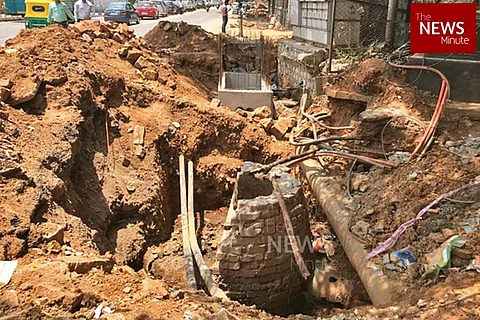

Two months ago, the pavements on both sides of Dhanavatri Road near Bengaluru’s Majestic area was dug up for the Karnataka Government’s ambitious TenderSURE project under the Nagarottana Scheme.
Bigger pavements, better roads and more greenery- this was the plan.
But what the road contractors found seems like a repeat of what happened in Church Street. Work to beautify Church street that started in February 20177 ended in March 2018, after four deadlines were missed.
The horror of muddled up sewage system and haphazardly laid electric cables that haunted officials from Bruhat Bengaluru Mahanagara Palike (BBMP) at Church Street havereturned as an impediment.
At Dhanavatri Road, a 1.5 ft wide drinking water pipeline, which is over 30 years old has developed cracks in several parts and has leakage issues.
Besides, the sewage chamber, which is made of bricks has pipes from all directions connected to it. “This chamber was probably built in the 1960s and the sewage flowing from all areas in Majestic meet here and this chamber is ultimately connected to the main rajakaluve (storm water drain) in Malleshwaram,” said Sanjeev Kumar, the supervisor at the construction site.
Workers deployed at Dhanavatri Road say that the major problem is that electricity, water, sanitary and sewage connections have all been laid out in a haphazard manner, making it difficult for them to carry out their work.
“When we dug up the side of the road, we realised that the sewage chamber was damaged. The second issue is with the electricity cables. It is so difficult to figure out where they come from and what they are connected to. When new cables are laid, instead of taking out old cables, they have just let it rot here. Now we have to check whether they are live cables or not,” a worker at the site told TNM.
According to a senior BBMP officer, the absence of utility maps is affecting work. The workers end up digging up roads with no idea of what lies underneath, he adds.
“The same thing had happened in Church Street and now it is happening in other places to. It is decades of bad planning and lack of foresight. No one has maintained any maps of what lies underneath the roads, what cables are placed where and which directions the pipes go in. Now, it has become a guessing game,” the senior official added.
The (BBMP) had issued tenders to Amrutha Constructions to carry out works on six major roads in the Majestic, Gandhinagar and KR Puram areas - including Dhanavantri road, WH Hanumanthappa Road, Ramachandra Rao Road, Subedar Chatram Road, Gubbi Thotadappa Road, and KR Market area main road.
The Bengaluru Traffic Police, however, had granted permission to carry out works only on three stretches - Dhanavantri road, WH Hanumanthappa Road and Ramachandra Rao Road.
The entire project will see the reconstruction of 10.5 km of roads at an estimated cost of RS 105 crore, which is being funded by the Karnataka government under the Nagarothana grants.
According to BBMP Chief Engineer, Projects, KT Nagaraj, the construction of the three roads was initially expected to be completed in four months. However, the project completion has been delayed and the first phase will be completed only in the next six months, he says. “All the six roads will be completed by February 2020,” he says.
Speaking to TNM, Urban Planner Naresh V Narasimhan says that the problem cannot be fixed by reconstructing the main roads.
Narasimhan maintains that the reconstruction of the sewage system, water pipelines and storm water drains has to happen in every neighbourhood.
"If this is not done, then we will land up in the same mess where pipelines from residential areas are connected in the same spot where a new sewage chamber has replaced an old one. Cleaning up what is under the main roads is not enough. The government has to set up a task force. These members must be given decision-making powers so that they can easily approve plans to reconstruct the city's urban structure," Narasimhan says.
He points out that the major problem faced by those involved in the construction of TenderSure projects in that the contractors have to run from the BBMP to the BWSSB and the Bescom before they carry out any repair works at any given point of time.
"Half the delays are because of the red tape. This needs to be fixed," he adds.